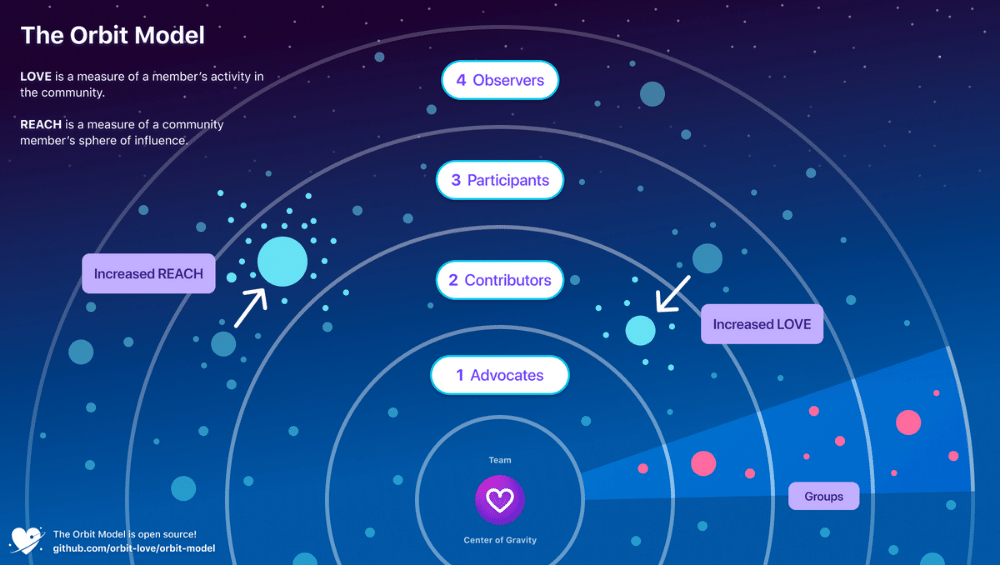Contents
Just like in a solar system, where planets and celestial bodies of all shapes and sizes orbit around a central mass, members of a community act in a similar way.
Some community members orbit closer to the center and pass by frequently, while others stay further out and are only seen occasionally.
A community with a high gravity attracts and retains members by providing an outstanding member experience and increasing the bonds between members.

In a solar system, everything revolves around the sun. Similarly, in a community, members revolve around a shared mission and values.
As they orbit, they build a network of relationships that helps the community accomplish its goals. The mission, values, and connections act as forces that attract and retain members.
This is called gravity. A community’s gravity causes members to pull themselves closer to the center.
All members start on the outer rim, and some become highly engaged members and orbit closer to the center. These movements determine each community’s unique field of gravity.
Gravity = Mission + Values + Connections
Communities with higher gravity can handle more growth without losing connections. In practice, this is because members who increase their commitment level can meet, guide, and help integrate new or less involved members.
A high-gravity community can move members at each level of involvement up to the next level efficiently and reliably.
A low-gravity community struggles to integrate new members and help them reach higher levels of involvement.
As a metric, gravity is a measure of how quickly member involvement is changing. In the Orbit Model, each member has two characteristics that help us understand the unique role they play and how to serve them best, increasing gravity as a result. These are love and reach.
Love
Love is a measure of a member’s involvement in the community. Love increases as members journey from being new arrivals to regulars to leaders. Communities need a certain number of high-love members to help direct people and resources toward the company’s mission.
High-love members are important, but so are members with every other amount of love. Most communities need a balance between high, medium, and low love members.
Understanding the balance is necessary to using gravity as a tool for planning growth since it’s best to add new, low-love members only when there are enough medium and high-love members to support and interact with them.
Reach
Reach is a measure of a community member’s sphere of influence and takes
into account their reputation, credibility, and degree of connectedness.
High-reach members know many other members of the community. Information is likely to flow through them, and their actions are likely to be influential, causing others to follow.
As a metric, reach considers the number of connections a member has, the strength and freshness of those connections, and how centrally their individual web of connections places them within the network.
The impact of a community is the set of outcomes that happen thanks to the work and operation of the community.
When a business invests in the community, the community returns the investment by creating more revenue, leads, visitors, partners, products, support, social impacts, and more.
In the Orbit Model, each community-to-business process is described as a flywheel, because the outputs of each process step feed back in as input.
For example, when happy customers become advocates, they draw in more happy customers who become more advocates. As the wheel spins, the outputs multiply.
Roles group members according to the jobs they do in the community. Roles can be acquired by doing certain activities or assigned by community leaders.
Roles are a good way to increase love, as they provide clear paths and often come with expectations around the frequency of participation.
Plus, people just like to know what they are supposed to do and how often.
Orbit levels are a practical tool for grouping community members according to their level of involvement, i.e. their love.
Orbit levels are used to personalize member experiences, recognize & reward participation, and design focused community programs. They’re useful as a shared organizational vocabulary.
When communicated to members and associated with privileges and benefits, levels can be used to create powerful incentive programs.
To use orbit levels, we need a system to decide how to place members in each level. There are two primary signals that we can use:
- the commitment level of their activities
- the frequency of their participation
Summary
To recap, in the Orbit Model of community building, here are the key terms your should know:
- Gravity – the rate at which member involvement is changing; measured at the community level
- Love – the measure of an individual member’s involvement based on their presence and involvement; measured at the individual member level
- Reach – the measure of a member’s sphere of influence; measured at the individual member level
- Impact – the outcomes that happen due to the operation of the community; measured at the community level
In order to comprehend each community member, you need to understand the orbit model. You should be building high gravity communities and reward each member’s love level.
Bigger companies that are diving deep into community marketing usually have their own orbit team, full of community managers and other marketing professionals to work towards the same goal.
Contents